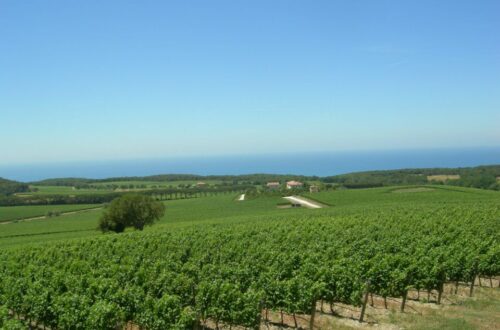A hidden jewel of Alto Piemonte, crafted from ancient soils and a legacy nearly lost to time.
In the northern reaches of Piemonte, where the Alps cast their cooling influence and volcanic soils meet centuries-old viticulture, lies Vino Boca DOC – a wine whispered about by collectors and adored by those lucky enough to taste it. Often overshadowed by Barolo and Barbaresco, Boca stands apart for its poise, age-worthy elegance, and rarity. With fewer than a dozen active producers, it’s one of Italy’s most elusive Nebbiolo expressions.
Quick Facts: Vino Boca DOC
| Fact | Details |
| Region | Alto Piemonte, Northern Italy |
| Main Grapes | 70–90% Nebbiolo (locally Spanna), plus Vespolina & Uva Rara |
| DOC Status | 1969 |
| Minimum Aging | 3 years (2 in oak) |
| Best Producers | Le Piane, Vallana, Antoniotti, Conti |
| Rarity Factor | Fewer than 30,000 bottles/year |
| Best Vintages | 2010, 2013, 2016, 2019 |
Table of Contents
What is Vino Boca DOC?
Vino Boca DOC is an elegant, high-altitude Nebbiolo-based wine grown on ancient porphyry soils in Alto Piemonte. The grape mix – mainly Nebbiolo (Spanna), with small additions of Vespolina and Uva Rara – delivers a wine of fine tannins, mineral precision, and complex aromatics.
History & Origins
Boca’s wine heritage dates back to Roman times, but its golden age came in the 19th century, when Alto Piemonte wines were as prestigious as Barolo. Industrialization, phylloxera, and rural depopulation nearly erased Boca from Italy’s wine map. A revival began in the late 20th century, led by Christoph Kuenzli of Le Piane, who restored abandoned vineyards and renewed interest in the appellation.
Geography & Terroir
Boca sits at 420–500 meters elevation, benefiting from Alpine breezes and diurnal temperature shifts that preserve acidity and aromatics. The region’s volcanic porphyry soils impart a distinct mineral backbone, setting Boca apart from the calcareous clays of Langhe.
Grape Varieties & Winemaking
- Nebbiolo (Spanna): Structure, floral aromas, longevity
- Vespolina: Peppery spice, color depth
- Uva Rara: Soft fruit notes, roundness
Wines must age a minimum of 3 years, with at least 2 in oak barrels. Many producers extend maturation for added complexity.
Top Vino Boca DOC Producers (with tasting styles)
- Le Piane – Benchmark elegance, layered minerality
- Vallana – Historic estate, age-worthy bottlings
- Antoniotti – Rustic authenticity, spice-driven profile
- Conti – Small family estate, artisanal methods
Vintage Guide & Drinking Windows
- 2010, 2013, 2016, 2019 – Exceptional structure and balance; cellar-worthy
- 2017 – Warmer vintage, softer tannins, earlier drinking
- 2020 – Promising young wines with freshness
Boca vs Barolo vs Barbaresco
| Wine | Region | Style | Cellaring Potential |
| Boca | Alto Piemonte | Mineral, floral, linear | 15–25 years |
| Barolo | Langhe | Powerful, tannic | 20–30 years |
| Barbaresco | Langhe | Elegant, perfumed | 15–25 years |
Food Pairings
Pairs beautifully with:
- Brasato al Nebbiolo (braised beef)
- Wild mushroom risotto
- Toma & Castelmagno cheeses
Serve at 16–18°C in large Burgundy glasses.
Where to Buy Vino Boca DOC
Due to low production, Boca is often available only through specialty retailers or directly from producers.
- Vinous.com Marketplace
- Wine-Searcher
- Importers specializing in Alto Piemonte
Collecting & Investment Potential
Boca’s scarcity, critical acclaim, and aging ability make it a smart cellar investment. Top vintages can appreciate significantly over a decade.
Visiting Alto Piemonte’s Boca Wine Trail
The village of Boca offers a quiet wine escape, with cellar tours at Le Piane, Antoniotti, and Vallana. Combine your visit with nearby Gattinara and Ghemme for a full Nebbiolo immersion.
FAQ
Q: How does Vino Boca compare to Barolo?
Boca is more mineral and high-toned, with lighter tannins.
Q: How rare is it?
Less than 30,000 bottles are produced annually.
Q: How much does it cost?
Typically €25–€60, depending on producer and vintage.
Q: How do you pronounce Boca?
“BOH-kah.”
CTA for Audience Engagement
Have you tasted Vino Boca DOC?
Share your tasting notes in the comments or tag us on Instagram with #DrinkItalianBoca – we might feature your pairing on our page.


